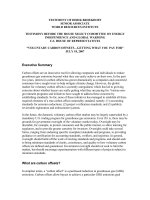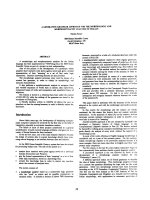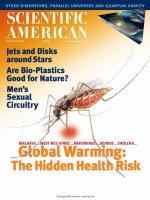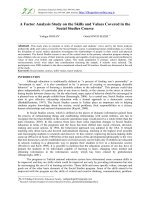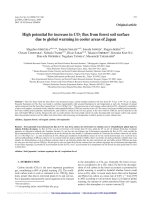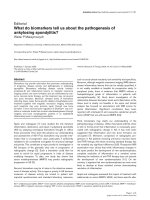under a green sky - global warming, the mass extinctions of the past, and what they can tell us about our future
Bạn đang xem bản rút gọn của tài liệu. Xem và tải ngay bản đầy đủ của tài liệu tại đây (1.93 MB, 258 trang )
UNDER A
GREEN SKY
GLOBAL WARMING, THE MASS EXTINCTIONS OF THE PAST,
AND WHAT THEY CAN TELL US ABOUT OUR FUTURE
Peter D. Ward
The climate is like a wild beast, and we’re poking it with sticks.
— C L I M AT O L O G I S T W A L LY B R O E C K E R
Contents
Epigraph
iii
I N T R O D U C T I O N : Going to Nevada
vi
C H A P T E R 1 . Welcome to the Revolution!
1
C H A P T E R 2 . The Overlooked Extinction
37
C H A P T E R 3 . The Mother of All Extinctions
61
C H A P T E R 4 . The Misinterpreted Extinction
87
C H A P T E R 5 . A New Paradigm for Mass Extinction
107
C H A P T E R 6 . The Driver of Extinction
131
C H A P T E R 7 . Bridging the Deep and Near Past
141
C H A P T E R 8 . The Oncoming Extinction of Winter
155
C H A P T E R 9 . Back to the Eocene
169
F I N A L E : The New Old World
193
Specific References Alluded to in Text
205
Index
225
About the Author
Credits
Cover
Copright
About the Pulisher
INTRODUCTION
Going to Nevada
S
eattle-Tacoma International Airport at dawn: Even in the gloaming, a bright, sterile, exceptionally hideous example of twentyfirst-century American architectural ugliness seems like a suitable
send-off point toward a past perhaps even grimmer than our climatic
present—but perhaps no more so than our possible future. The waiting lines, the ritual undressing of shoes and belt, the blank scrutiny
of identification and tickets, followed by the cattle-like entry into the
flying silver tube to find the assigned middle seat between well-stuffed
strangers for the supposedly short flight, giant engines snarling out
clear but heat-soaking vapors of jet engine residue into the atmosphere,
and from the window now high above the world, an amazing sight to
a Pacific Northwest native: the high Cascades virtually without snow
on this early April 2005 day, following the warmest and driest winter
in Pacific Northwest history, ski areas going broke as rock skiing loses
clientele not pleased with the necessary artificial ice at Snoqualmie,
Stevens Pass, Whistler Blackcomb, Grouse Mountain, and Crystal
vi
INTRODUCTION
Mountain ski areas, among many others showing summer rocks in
winter. Even Mt. Rainier seems rockier than usual, its glaciers beating a hasty retreat and leaving behind 12,000 years of rocks, airplanes,
and human or other animal frozen food long ago lost. The whole, dry
mountain range, visible to our Nevada arrival, flaunts its uncovered
geology until we circle the Reno basin, touch down; the slow exit from
the plane into a different ugliness where the volume and brightness of
the movie we have found ourselves in has been jacked off scale in fine
William Gibson style. Reno-Tahoe International Airport, where even
the gates are stuffed with slot machines screeching a cacophony of enticement at frantic decibel overkill, electricity be damned. Out of the
airport to the rental car, a huge sport-utility vehicle, of course, and for
once a necessity for where we are going.
We rocket out of the parking lot, screaming through Reno on the
freeway east, passing quickly into the empty rat lands of the sorely
missed Hunter S. Thompson, tripping out at the absolute ugliness of
a landscape repellant to begin with that has had twisted, rusting metal
hulks of unknown ancestry sprinkled among the itinerant whorehouses and casinos in a random pattern across its waterless salt flats
and outcrops. Two hours of driving fast (but not fast enough, as muscle
cars snarling their high-speed anxiety whiz past toward nowhere and
everywhere) brings us to Hawthorne, Nevada, whose largest structure
is of course the casino, cigarette smoke venting from its few stained
windows like some belching coal-fired Oliver Twist factory plant of
Dickensian England, past the one museum in town—slower now,
ogling the Armament Museum, where at least one model of every
shell casing ever used by the town’s biggest employer, the U.S. military, sits in forlorn splendor all with flowers bravely growing from the
brass openings on top, a ’60s dream come true. To the biggest motel
in town to toss now-opened bags onto swaybacked beds, liberating
the boots, leather, vests, and cold steel anathema to airline carry-ons,
vii
INTRODUCTION
and now looking like Halloween imitations of desert rat miners, we
point the car east and south, and for mile after tens of miles pass the
damnedest-looking B-movie bunkers extending as far as the eye can
see, seemingly millions of the squat concrete burial mounds marking
the storage of unknown tons of live munitions in quantity probably
second only to that held by the insurgents in Iraq. An hour of this,
finally into Luning, and damn, the Luning Bar, looking like it always
has (early and late Nevada spider-webbed rattrap décor), sits closed, so
no eye-opener on the way to the outcrop.
We leave the highway and all those muscle recreational vehicles
around us that are making the long trek to Vegas across the Nevada
no-man’s-land and shoot onto the wide, pale playa, an old lake bed of
Ice Age antiquity that stands between us and the hills ahead, the raucous backseat crew calling without success for a few 60-mile-per-hour
wheelies in the lake bed. The track becomes fainter, and we enter the
hills in four-wheel drive, the motor growling in protest as we lurch
into high canyons, while the navigator beside me is covered with maps
and barking directions over the din, impatience thick now, to a turnout
well known from past trips here, the setting-out point for the trail to
Muller Canyon, the best example of rocks clutching one of the five
largest of all mass extinctions, that at the end of the Triassic period,
a catastrophe of 200 million years ago conveniently blamed on a Big
Rock From Space smashing into a Triassic world populated by early
mammals and dinosaurs as well as croc-like beasts galore on land and
oceans of ichthyosaurs, ammonites, and strange flat clams, secure as
such dumb brutes can be, not knowing that their world was one day
from over according to twenty-first-century cant, the only problem being that our previous trips to this barren place did not yield the faintest
whiff of iridium or glassy spherules or shocked quartz or impact layers
so visible in that other known impact extinction, that at the end of the
Cretaceous.
viii
INTRODUCTION
Sidestepping across the high hills on the faint path through the piles
of strata all around, rocky layers once neatly and horizontally ordered
but now layers akimbo, fractured with faults, and burrowed with Saddam spiderholes made by Cowboy Age miners looking for riches in the
worst possible place to find material wealth and the best possible place
to disinter the dead and interrogate them about the identity of their
killer. Mountain sheep jump in fright as we come over the last hill onto
the steep slope of our target outcrop—damn and finally—hundreds
of feet of limestone sandwiching a 60-foot-thick band of mudstone
containing some level where the Triassic ends and the Jurassic begins,
and the realization yet again that this is another of the planet’s stony
cemeteries. A long scorpion pit where we dug in search of this supposed disaster level last time here, a trench now permanently part of
the landscape, but in the sins committed against our planet, it hardly
registers. The limestones above and the limestones below are packed
with life, mainly mollusks, a good Triassic fauna below, a good Jurassic
fauna above, and what a supreme difference those two worlds show
with clearly almost no survivors of some catastrophe grabbing the
river of life and giving it a 90-degree kink into a whole new assemblage
of life, the real start to the Age of Dinosaurs after the experimental
mucking about in drifting evolution that was the Triassic.
So how about that 60-foot-thick siltstone, almost bereft of fossils—what caused it? But a year or so ago the answer would have been
knee-jerk recital: The fossilized dead bodies are evidence of a mass
extinction, and since the groundbreaking 1980 discovery of the Alvarez team from Berkeley that the Age of Dinosaurs was ended by an
asteroid strike from space, the geological fraternity has pronounced
all mass extinctions to have been guilty of asteroid impacts until
proven otherwise. Now we are not so sure, for none of the telltale
clues of such a cosmic event are in evidence here. Yet if not asteroids
or comets from space, what? Exonerating the asteroids leaves but a
ix
INTRODUCTION
few suspects, and by 2005 one deemed most likely was, and remains,
rapid climate change and really fast global warming brought about by
not a little methane and a whole lot of carbon dioxide poured into this
world from volcanic smokestacks and deep sea bubbles of poisonous
greenhouse gas burped out of the sea but one of a series of such mass
extinctions, greenhouse extinctions, the rule not the exception, and a
road we humans might again travel on now, seemingly oblivious to the
road washout ahead, an accident about to happen one more time, or,
if we interpret the rock record correctly, many more times.
From the top of our outcrop a valley spreads out, and in the distance the ribbon of road we had left still carries the endless number of
cars toward Vegas and the chance to roll the dice, to hit the jackpot,
but some number of them will bust instead, just as the Triassic world
did, a bust that meant the death of 60 percent of all species on Earth.
And guess what—our world is rolling the same set of dice.
In this book I will marshal the history of discovery, beginning in
the 1970s, that has led an increasing number of scientists across of
broad swath of fields to conclude that the past might be our best key
to predicting the future. As strewn across this barren, nearly lifeless
hillside in the nontouristy middle of Nevada, if there is even the slightest chance that the carbon dioxide in Earth’s atmosphere of 200 million years ago caused this mass extinction, as well as numerous other
times before and since that ancient calamity, then it is time for we practitioners who study the deep past to begin screaming like the sane
madman played by Peter Finch in the classic 1976 film Network, who
brought forth his pain with the cry: “I’m as mad as hell, and I’m not
going to take this anymore.”
In our case, this cry must be: “I am scared as hell, and I am not going to be silent anymore!”
This book is my scream, for here in Nevada, on that day when
heat was its usual quotidian force of death, we sat on the remains of
x
INTRODUCTION
a greenhouse extinction, and it was not pretty, this graveyard, the evidence clutched in these dirty rocks utterly demolishing any possibility
of hyperbole. Is it happening again? Most of us think so, but there are
still so few of us who visit the deep past and compare it to the present
and future. Thus this book, words tumbling out powered by rage and
sorrow but mostly fear, not for us but for our children—and theirs.
xi
CHAPTER 1
Welcome to the Revolution!
Z U M AYA , S P A I N , J U LY 1 9 8 2
A
warm but wet wind from the sea, a wind pushing gray scudding clouds onshore from the squall-torn Bay of Biscay greeted
the two geologists as they slowly drove through the narrow,
building-lined streets of a small, tiled Basque town named Zumaya, in
the quiet of an early Sunday morning. Their knees were still cramped
from the daylong drive of the day before, when they had crossed the
neck of France by a route that began on the sun-kissed Mediterranean coast at Banyuls-sur-Mer in the Languedoc region, then clung to
the edges of the rugged Pyrénées Mountains for their entire south to
north length before ending late that night at a cavernous and gloomy
hotel perched on the stormy Atlantic Ocean coast in the Basque city
of San Sebastián, Spain.
One of the two was Jost Wiedmann, a famous German paleontologist from Tübingen University, itself the most famous and storied paleontological center in the world. He had spent his career studying the
geological ranges of one particular group of fossils, one of the most
1
UNDER A GREEN SKY
celebrated of all fossil groups, the ammonite cephalopods. He practiced the standard methodology of his German predecessors: studying
the collection of the fossils from known locations in strata to produce
a “biostratigraphy,” literally the differentiation of the many great piles
of sedimentary or layered rock so prodigiously scattered across Earth’s
crust. His particular interest was mass extinction, those short-term biotic catastrophes that were the most dramatic bookmarks in the tables
of strata. He had spent much of his fieldwork among the strata of
the Cretaceous period making up the fabulously beautiful coastline of
France and Spain known as the Basque Country, a place inhabited by a
dour race still wishing to be known as a country separate from either
France or Spain.
Wiedmann had published widely reports that the ammonites
showed no evidence of a rapid extinction but of something quite different. In a number of famous papers that had been published in journals read not just by the small band of professional paleontologists but
also by a far wider spectrum of geologists and evolutionary biologists,
Wiedmann had presented evidence that the final extinction of the ammonites was the final act of a long, slow diminution of diversity that
had lasted more than 20 million years. By the end, almost none were
left anyway, making the K-T event (an event straddling the Cretaceous
and Tertiary periods) a minor extinction at best—at least for the ammonites.
I was the other member here, at that time a young American from
the University of California, Davis, one of the new breed of American scientists who styled themselves as “paleobiologists,” not one of
the paleontologists of old, in an effort to bring new intellectual vibrancy into the oldest field of Earth science, paleontology, by trying
to master two fields, not just one. I had completed two quite different
research projects for my still rather newly minted Ph.D., the central
goal of which was an attempt to understand how the long-extinct am2
W E L C O M E TO T H E R E VO L U T I O N !
monite cephalopods could, after a wildly successful existence on Earth
of more than 360 million years, would have gone extinct, while their
nearest, lookalike relatives, the still living chambered nautilus, had escaped that fate at the end of the Cretaceous period. I had approached
this topic from two different directions, one very nontraditional. The
old-school approach was the study of the fossils themselves: anything
defective here, any morphology antiquated there, as I examined fossil after fossil over a 20-million-year period prior to their final extinction? Actually, pretty boring work. But the other was a very different
approach. Long a deep-water salvage diver of professional skill and
experience, I had through chance and fortitude talked my way into a
research grant that took me to the one place on Earth where a living
nautilus could be actually seen in the wild, the island of New Caledonia, some 700 miles east of the Great Barrier Reef region of Australia.
Since that four-month expedition in 1975, I had managed to spend at
least a month each year in the water with the wild nautilus and by
this time in 1982 had expanded my study area to include Fiji, and I
was anticipating with enormous excitement my 1983 field season, already planned for Palau, Micronesia, home to the largest nautiluses
(and most beautiful reef walls) in the world. Even the cuttlefish there
were giant.
In those years, work with the nautilus was directed by questions
that more traditional biologists had never asked of this oldest of cephalopod mollusk, ones that hopefully could shed light on the life span,
growth rate, food, and predators of the nautilus that might through inference inform about the ammonites as well, and year by year I arrived
in the sunny tropics with better equipment, more grant money, and
new ideas and colleagues. But this side of my scientific schizophrenia
was increasingly shoving aside geological pursuits, and my presence in
Europe in the summer of ’82 was not to study fossil ammonites but
to look at another living cephalopod that might lend insight into the
3
UNDER A GREEN SKY
ammonites, a squidlike animal known as the cuttlefish. This work had
drawn me to France, and it was a sheer accident that a chance letter
to Wiedmann had led to this invitation to visit one of the few sites on
Earth where fossil ammonites could be found in stratigraphic sections
with both youngest Cretaceous and oldest Tertiary found in a continuous and well-exposed outcrop.
Wiedmann was definitely old school, a classically trained paleontologist. Sadly enough for the field, by the middle of the twentieth
century when Wiedmann had trained in the carnage and chaos of immediate post–World War II Germany, the discipline of paleontology,
once a vibrant and necessary area of science important in the study
of evolution, had become a sleepy enclave whose every practitioner
could spend an entire career writing detailed monographs about the
slight differences to be found among the fossil brachiopods of Iowa or
among the fossil rodents of Wyoming, studies interesting in their own
right but adding very little to larger scientific problems of the time.
There were no longer great intellectual questions that demanded the
presence of paleontologists at what one eminent British scientist referred to as the scientific “high table.” And then, as if out of the blue,
a 1980 paper published in Science magazine brought the chance of redemption to the field of paleontology, for it was in that year that a
group from the University of California, Berkeley, led by a father-son
team of Luis and Walter Alvarez, published a bombshell paper forcefully advocating that the K-T extinction was not the consequence of
long-term climate change on a multimillion-year time scale but rather
was the consequence of a titanic impact of an asteroid with Earth.
The Alvarez group proposed two testable hypotheses: that Earth had
indeed been struck 65 million years ago by an asteroid estimated to
have been 10 kilometers in diameter and that the mass extinction was
caused by the catastrophic environmental changes to air and water in
4
W E L C O M E TO T H E R E VO L U T I O N !
the hours, days, and months following the calamitous, really bad day
on planet Earth.
What would have killed everything? screamed critics in the weeks
following this momentous and eventually paradigm-changing paper.
The number of organisms actually killed by the falling rock would
have been limited to some few hundreds of square miles. But the surface of Earth is a lot bigger. First the Alvarez group and then others
put forth ideas about the actual death mechanisms.
The ultimate killer, according to Alvarez et al., was a several-month
period of darkness, or blackout, as they called it, following the impact.
The blackout was due to the great quantities of meteoric and Earth
material thrown into the atmosphere after the blast, and it lasted long
enough to kill off much of the plant life then living on Earth, including the plankton. With the death of the plants, disaster and starvation
rippled upward through the food chains.
Several groups have calculated models of lethality caused by such
atmospheric change. Apparently a great deal of sulfur was tossed into
the atmosphere. A small portion of this was reconverted into H2SO4, or
sulfuric acid, which fell back to Earth as acid rain; this may have been
a killing mechanism but was probably more important as an agent
of cooling than direct killing through acidification. However, more
deleterious to the biosphere may have been the reduction (by as much
as 20 percent for 8 to 13 years) of solar energy transmission to Earth’s
surface through absorption by atmospheric dust particles (aerosols).
This would have been sufficient to produce a decade of freezing or
near freezing temperatures on a world that, at the time of impact, had
been largely tropical. The prolonged winter is thus the most important killing mechanism—and it was brought about by vastly increasing
aerosol content in the atmosphere over a short period of time.
Perhaps the most ominous prediction in this model is the formerly
5
UNDER A GREEN SKY
unappreciated effect that the giant volume of atmospheric dust generated by the impact has on the hydrological cycle. Globally averaged
precipitation decreased by more than 90 percent for several months
and was still only about half normal by the end of the year. In other
words, it got cold, dark, and dry. This is an excellent recipe for mass
extinction, especially for plants—and the creatures feeding on plants.
How to test this hypothesis? More sections of K-T age had to be
studied, and those studies had to go in two very different directions.
First, geologists specializing in geochemistry had to ascertain if mineral and chemical samples from thin “boundary” layers showed the
same kinds of evidence that had first led the Alvarez group to this
sensational report. But secondly, the fossil record prior to those beds
containing evidence of the catastrophe had to be studied, and studied
in far greater detail than had been done before. It was pretty intuitively simple what the fossil record should look like as a result of an
impact: There should be lots of fossils at constant diversity right up to
the impact layer—and then a vast disappearance of both individuals
and species should be very obviously appearing. But the Alvarez team
contained no paleontologists. And thus paleontology was given an unexpected pass to the “high table” in one of the most important discoveries of any science ever. One of the greatest questions was as follows:
The sections studied by the Alvarez group were found in Italy, near
the town of Gubbio. The beautiful limestones making up these rocks
had been deposited on a quiet, deep seabed. But the very depth of
the water meant that deposition took place in an underwater environment that had few larger animals living above, on, or in it. This deep,
black sea bottom had at most a sea urchin or two. What it did have
in abundance were untold numbers of microfossils, mainly from two
groups. Specialists showed that the fossil records of foraminifera and
coccolithophorids showed the predicted pattern of sudden extinction.
But because no larger fossils—such as the all-important ammonites—
6
W E L C O M E TO T H E R E VO L U T I O N !
existed in these rocks, the major question as to whether the impact,
if it happened at all, had killed off the more celebrated of the larger marine animals, from ammonites to clams to fish, to the largest
marine reptiles such as mosasaurs—let alone the most iconic Cretaceous inhabitants—the terrestrial dinosaurs—could be answered only
through the study of other sections. A huge opportunity was presented to the paleontologists. As it turned out, in the majority of cases
the paleontology community was not up to the challenge. The paleontologists who studied vertebrate fossils were the most vehement in
their opposition, and ironically, the leader of the anti-Alvarez forces
was vertebrate paleontologist William Clemens, a specialist on the last
dinosaurs in Montana who, like the Alvarezes, worked at Berkeley.
The search was on for stratigraphic sections, places where piles of
sedimentary rock of latest Cretaceous and earliest Tertiary age, could
be studied. The most useful of these would be sections with the largest variety of fossils available. As it turned out, some of the best of
these in the world were the Basque seacoast cliffs. Wiedmann was the
geologist with the most experience in these rocks, and through this
twist I held keys to important questions. And since paleontologists are
very territorial about their established field sites—more so than practitioners of other fields are of their own—Wiedmann found himself in
a rather enviable position. Thus, my excitement was enough to help
me talk my way into a tour of the most important of the Basque sites,
the seacoasts at Zumaya.
We parked high above the ancient Zumaya town square, geared
up, and began the quarter-mile hike along a narrow sheep path leading to a steep stairway giving access to Zumaya’s rocky beach. These
stairs had been cemented against—and in some places carved out of
an enormous bedding plane of—sedimentary rock, hundreds of feet
to a side, an originally flat sheet of strata deposited on a deep bottom
66 million years ago but thrown up some lesser millions of years ago
7
UNDER A GREEN SKY
as a consequence of the tectonic formation of the Pyrénées mountain
chain and now rakishly tilted skyward. Back in the Cretaceous, when
this huge stratal surface was but a tiny part of a sea bottom covering
the oceans of the entire world, its limy bottom had enough internal
consistency that every movement of the varied invertebrates left a trail
in the sediment, eventually cemented to form what is known as trace
fossils. Worms, crustaceans, echinoids, starfish—all moved across the
bottom on a day of their daily lives, and while perhaps none ever made
the immortality of body fossil preservation, their behavior was preserved, a testament to the geologists of just how alive that ancient Mesozoic world was before its sudden end, and a stark reminder as well
of how few are the kinds of animals that leave fossils, shells, or bones
behind at all. The stairs passed down across this track-marked stratum,
a painting of a long-gone world.
At the bottom of the stairs, we headed north, scrambling over the
wet and slippery maroon strata, more than once slipping into the waiting sea or tide pool, barking shins or scraping skin on the razor-sharp
barnacles in the process. But the pounding surf on the rocky points,
the scudding clouds, and the vast cliffs that echoed back the crashing of waves on rock vastly overawed these temporal nuisances as we
scrambled up and over stratal ridge after ridge, each several-inch to
several-foot limestone layer representing 24,000 years, the limestone
alternating with darker shale and all controlled by orbital cycles first
discovered by a Russian named Milutin Milankovich. The last rocky
point, made up of several dozen of these couplets, was the most difficult of all to get over, for like the huge stratal sheet with the stairway,
it was tilted about 60 degrees from horizontal, too steep to climb, too
steep to safely slide down, and here there was no providential stairway
built by obliging Basques. Lowering ourselves hand over hand, the last
10 feet an ignominious slide into a cold tide pool at the bottom of
the stratum, a now thoroughly wet duo at last stopped to admire the
8
W E L C O M E TO T H E R E VO L U T I O N !
grandeur of what earlier geologists had aptly named Boundary Bay.
Huge walls on three sides enclosed the large bay with a flat, rocky
bench about the size of a basketball court exposed at lowest tide, in
the rear of the large box canyon, a strand completely water covered at
high tide. It was like being in a huge cathedral where the roof and one
wall had been taken off, the sheer wall-like cliffs rising a hundred feet
or more above the small beach, each wall brightly colored as if painted
by some giant. The rocks to the south were a deep maroon in color,
those to the north a brilliant white and pink striping. And in the center
of the back wall of the bay there was a meeting of the two different
units, a sudden transition from maroon beds below to pink and white
beds above, starting near the sea and then rising upward from the base
of this canyon as the tilt of the beds carried this K-T boundary layer,
one the year before discovered to be packed with all the hallmarks
of the K-T impact itself, the diagnostic iridium, shocked quartz, and
glassy spherules, all save the iridium originally Mexican inhabitants
that were now on permanent vacation at this beach (and at all other
K-T boundary sites as well over the entire globe).
We walked to this boundary, made up of about a foot of dark clay
sitting in between the much more gaudily colored rock layer of before
and after. The dark clay seemed an ominous marker, but in reality it
was an aftermath, not the calling card of the extinction itself. The rocks
above, the rocks below, both were light in color, and that lightness
came from the skeletons of untold numbers of calcareous skeletons
that had been secreted by microscopic, floating algae in the long-ago
latest Cretaceous and earliest Tertiary oceans. So abundant were these
tiny plants, known as coccolithophorids, that their dead settling skeletons painted the ocean bottoms a bright white, accumulating over
the eons into thick white rocks—the familiar chalk. The chalk seas
flourished before the extinction, and after, but not right after. For tens
of thousands of years after whatever caused the extinction, the chalk
9
UNDER A GREEN SKY
was nearly gone, death removing it from the seas. And in its absence
the only sediment grains reaching the seafloor were small grains of
rock eroding from the nearby land areas. It is this dark rock, bereft of
chalk skeletons, that made up the foot of dark clay, called the boundary clay.
But there was a final layer to reckon with here, the cause of the
entire ruckus, much thinner even than the clay layer. We scrunched
down, knees complaining as we knelt on the wet rock beneath to bring
our heads within inches of the uppermost Cretaceous chalk layer. I
pulled out a hand loupe, its ten-power lens briefly sending a moving
spotlight of bright light across the outcrop, like a balcony searchlight
moving from stage right to pick out the star of the show. In the lens
a thin, red layer of rusty-looking grains grew bold. This layer, an
eighth of an inch thick, was filled with small spheres of glassy material, as well as small fragments of rusted metal. But hidden in this
layer at even smaller size were metals even more rare than iron on a
Spanish beach: tiny grains of platinum and iridium, the stuff of stars
and the asteroids that circle them. Such a thin layer to cry out that
a world had ended in a crater ejecta bombardment, producing fire and
subsequent acid rain.
The extraordinary thing, not yet known then in 1982, was not that
this layer sat there sandwiched between vast piles of chalk layers, a
doomsday special of the epoch. No, the extraordinary thing was how
similar this layer looked to others even that summer being examined
by other geologists, at places in Europe named Caravaca, Agost, El
Kef, Sopelana, Bidart, Stevns Klint, all places where other thin impact
layers marked the end of so many kinds of marine life. And it was not
just Europe. The impact layer was eventually to be found in marine
strata exposed in Russia, the Crimea, Georgia, along a long area of the
Black Sea, all the way to Japan and New Zealand; it was found along
the east coast of North America, into the Caribbean, to South Amer10
W E L C O M E TO T H E R E VO L U T I O N !
ica, all the way to Antarctica. It even looked like layers found from
land-derived strata, in places such as Hell Creek, Denver, and Judith
River; up the Milk River regions of Alberta, and far into the Arctic.
That was the most salient fact learned from this event: Its calling card
was global and easily recognizable. There was a vast replication of this
sequence, and as geologists fanned out over the years to study these
places, there came a vast, comforting (for all but the ever-diminishing
ranks of naysayers) confirmation through replication of fossil records
terminating at chemically similar layers increasingly believed to have
been caused by the rainout of the vast crater carved into Earth, 65
million years ago.
We placed hands on the boundary clay, as if expecting some message from the dead, but there was nary a peep, so we began to work.
Starting at the point of catastrophe, with a meter stick, we began to
slowly measure the thickness of each bed, each number scratched into
a yellow field book; down section and thus back in time we went, bed
by bed, hour by hour. I was amazed as the German pulled out a spraypaint can and painted gaudy Teutonic numbers on the rocks of large
and ugly size, marking each successive 10-meter interval of strata beneath the K-T layer. Soon the tide began to rise, but by then we were
already out of Boundary Bay, repetition breeding more speed, but the
tide was not to be denied, and long before finishing even the 100 meters of stratal thickness between the K-T boundary and the stairwell,
we were forced out of the bay by the rising water. But the framework
for our morrow’s work was in place. Any fossil collected in the succeeding two days would be collected from a layer of a known distance
below the death layer.
It had been on the long drive of the day before that I had asked the
ever correct, pleasant, but distant German professor if the collections
from this place made over the many years of study by him and his
yearly group of spring-semester students could be used to test the sec11
UNDER A GREEN SKY
ond of the two hypotheses proposed in the 1980 Alvarez paper: that
the fossil record should show a catastrophic appearance, with many
species disappearing suddenly from the succession of beds in the layers just beneath the thin impact layer. Wiedmann pondered for a moment. “I doubt it,” he said. All of the hundreds of ammonites collected
over the decades were simply labeled as coming from Zumaya. But it
was his strong recollection that the ammonites disappeared gradually,
not suddenly, because that is how mass extinctions worked. All were
gradual.
I was silently astounded. Men such as Wiedmann had been my
heroes in grad school, and my own major professor had been Wiedmann’s fellow grad student in post–World War II Germany. Wiedmann himself had become the greatest expert on the extinction of
ammonites through each of the mass extinctions—and more. These
were the lineal descendents of the Teutonic, mid-nineteenth-century
fathers of biostratigraphy, the great Friedrich von Quenstedt, who had
demanded that his followers never tire of the exacting work of collecting fossils from known stratigraphic positions in the vast tables of strata, and his even more brilliant student, Albert Oppel, who pioneered
the use of fossils to produce the finest division of time possible, the
zone. Wiedmann, their heir, one of the godlike German professors of
paleontology, had apparently tired of the exacting work.
From the first announcement of its discovery in 1980, and then
continuing well into the 1980s, the Alvarez team exhorted paleontologists to test its groundbreaking hypothesis using fossils. To do that,
many different K-T boundary sections would have to be studied, and
Zumaya looked like a perfect testing ground for this most compelling
of scientific hypotheses. But it looked as if all new collecting had to
be conducted. The entire section had to be measured, and whenever
a fossil was found, it would have to have its level in meters below the
12
W E L C O M E TO T H E R E VO L U T I O N !
impact layer exactly noted. With enough collecting in this way, one of
the major predictions of the Alvarez impact hypothesis could then be
tested: Did the ammonites disappear suddenly or gradually? If many
species and individuals were found just below the boundary, it would
be evidence of sudden extinction. But a long, slow diminution would
be a major blow against Alvarez et al.
At the end of the two days, the approximately 50 fossils were
pried from the stratal walls, each from a bed of known distance below the boundary. Ultimately they were never to play any part in the
controversy, for a controversy was what this had become in the early
1980s. But one thing came through this first collecting attempt by the
young America and older German. Try as we could, neither of us had
been able to find an ammonite within 15 meters of the impact layer in
Boundary Bay, and both of us had come into our field with the ability
to find a fossil when no one else usually could. But not this time.
Wiedmann seemed very pleased. Whenever I brought up the Alvarez hypothesis, Wiedmann was wont to mutter a deprecation in German. Sudden extinction? Ridiculous. This was becoming the knee-jerk
reaction by all but the youngest (or really good older) paleontologists
worldwide. To these men (there were indeed very few women in the
field in the immediate post–World War II generation), there was no
way a mass extinction could have been catastrophically fast. Catastrophism was a failed nineteenth-century theory, and none of the powerful, mid-career European paleontologists of the early 1980s—and
very few of the Americans, either—were going to allow the field to
fall back into believing that failed idea. Only geniuses David Raup and
Stephen Jay Gould noisily demurred.
Wiedmann packed the fossils into his sporty red Audi (he was
newly divorced) and, dropping the American off at a train station,
sped off toward Germany and his more important projects, since he
13
